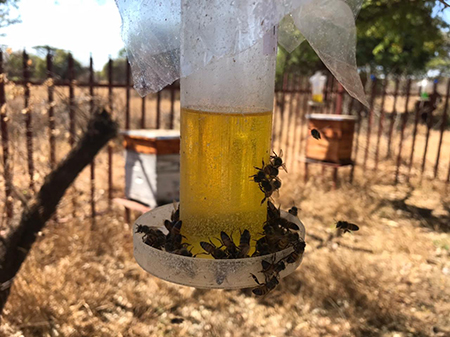The mesmerising world of honeybee foraging behaviour has long fascinated scientists, with colour playing a pivotal role in their quest for sustenance. Bees are essential pollinators that hold the key to maintaining the delicate balance of our ecosystems.
North-West University (NWU) student Kimani Waiyaki’s recent research delved into the intricate connection between honeybee foraging and colour preferences. His research titled “Unlocking the world of bee vision: Apis Mellifra’s colour preferences” unveils surprising findings that may have far-reaching implications for bee conservation and our understanding of their vision.
Kimani says during their foraging flights, honeybees encounter a kaleidoscope of floral species, each boasting an array of pigments and colours.
“Despite this visual diversity, these remarkable pollinators have exhibited innate preferences for specific colour characteristics. Notably, bees are drawn to colours dominated by blue wavelengths, hues with high contrast, and those characterised by high spectral purity. This phenomenon raises the question: How do bees respond to colours that challenge these predilections?”
Kimani sought to unravel the complexity of honeybee vision by presenting worker bees from managed colonies with sugar syrup dyed in various pigments, including red, yellow, green and blue. The results of this experiment have shed light on the intricate world of honeybee colour preferences.
“Intriguingly, the research findings challenge conventional wisdom. Red sugar syrup emerged as the most attractive choice for the bees, defying previous studies that suggested honeybees have limited sensitivity to red wavelengths. This revelation marks a significant breakthrough in our understanding of honeybee behaviour and their nuanced relationship with colour,” he says.
The implications of these findings are profound, as they offer opportunities to enhance the attractiveness of artificial diets designed to sustain honeybee colonies.
“By aligning these diets with honeybees' innate predispositions, we can potentially mitigate the consequences of natural forage depletion caused by habitat loss. This is particularly crucial in an era when honeybee populations are under threat due to various environmental factors,” adds Kimani.
“Understanding honeybee colour preferences not only benefits beekeepers and those involved in honeybee conservation efforts, but also has broader ecological implications. Bees play a vital role in pollinating plants, which, in turn, impacts biodiversity, crop yields, and the health of our ecosystems. By catering to the visual preferences of these diligent pollinators, we can encourage their foraging behaviour and support their critical role in maintaining the balance of our natural world.”
As scientists continue to unlock the secrets of honeybee vision and behaviour, it becomes increasingly evident that a nuanced approach to conservation and sustainable practices is essential. The humble honeybee, with its intricate relationship with colour, holds the key to a healthier and more vibrant planet.

Kimani Waiyaki.

Honeybees are attracted to colour.

Red sugar syrup emerged as the most attractive choice for the bees.
